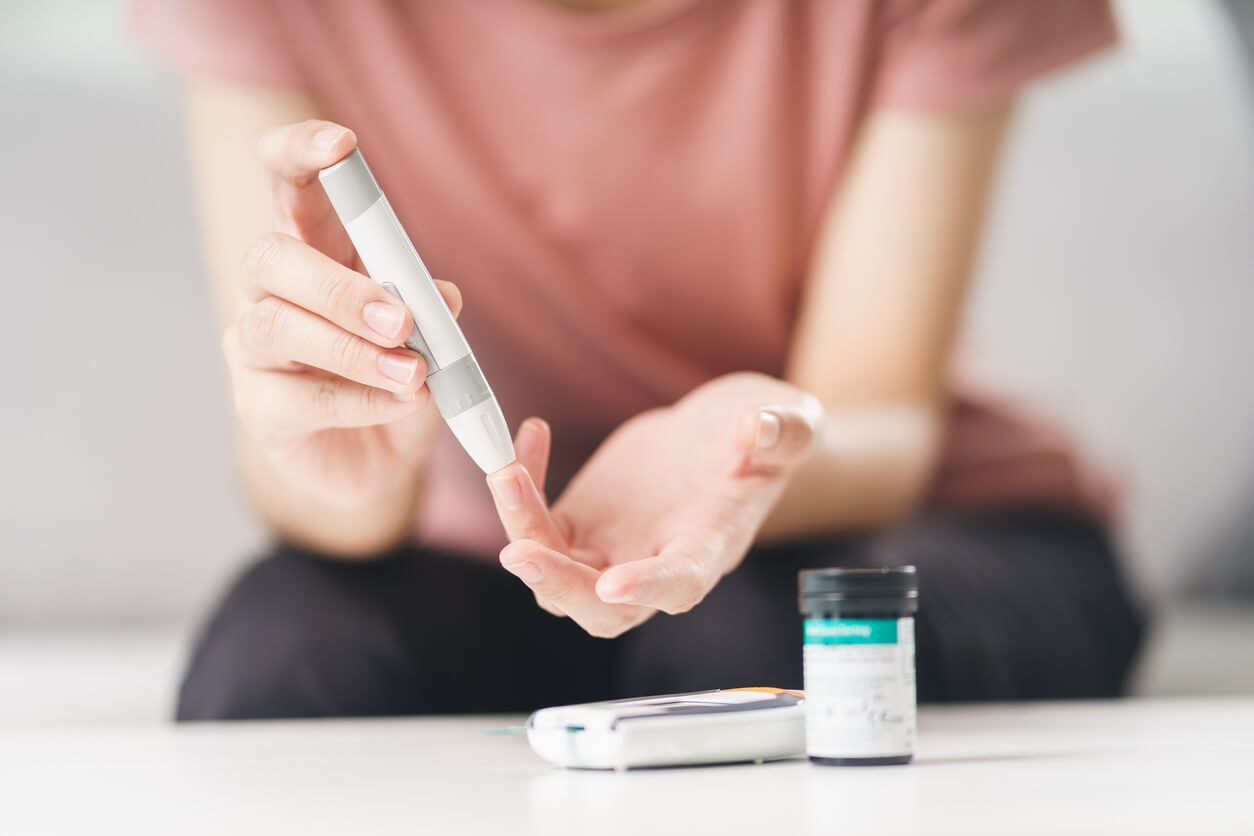Type 1 vs Type 2 Diabetes: What’s the Difference?
Examining the differences between type 1 and type 2 diabetes
Diabetes (diabetes mellitus) is one of the most common chronic diseases in America. A 2022 report from the Centers for Disease Control and Prevention (CDC) shows that over 37 million Americans have diabetes. 28.5 million adults have been diagnosed with diabetes, while an estimated 8.5 million people, or 23% of adults, have gone undiagnosed.
Despite its increasing prevalence, diabetes is still misunderstood by some. In this article, we will detail the similarities and differences between type 1 diabetes and type 2 diabetes to shed some light on these common conditions. We will look at the various causes of this disease, its symptoms, and the divergent treatment options for the different types of diabetes.
What is diabetes?
Diabetes is a complex and chronic medical condition affecting how your body processes and regulates blood glucose, a type of sugar that serves as a primary energy source for cells. It occurs when there is an issue with insulin, a hormone produced by the pancreas that plays a crucial role in controlling blood sugar levels. Insulin helps glucose enter your cells, where it is used for energy. There are two main types of diabetes: type 1 and type 2, each with distinct causes and characteristics.
Type 1 diabetes, often called insulin-dependent diabetes, is an autoimmune disease that typically develops in childhood or adolescence but can occur at any age. In this form of diabetes, the immune system mistakenly attacks and destroys the insulin-producing cells in the pancreas. As a result, people with type 1 diabetes produce little to no insulin and require lifelong insulin replacement therapy to survive.
On the other hand, type 2 diabetes is the more common form and usually develops in adulthood. However, it's becoming increasingly prevalent in children and adolescents in concert with rising obesity rates. In type 2 diabetes, the body still produces insulin but becomes less effective at helping glucose enter cells, a phenomenon known as insulin resistance. Insulin resistance leads to elevated blood sugar levels. This condition is often linked to lifestyle factors such as poor diet, sedentary behavior, and genetic factors beyond one’s control.
Diabetes can have a wide range of effects on the body if left unmanaged. Elevated blood sugar levels can damage blood vessels, nerves, and organs over time, leading to various complications. It's important to note that diabetes is a lifelong condition, and there is currently no cure. However, with proper care and management, individuals with diabetes can lead full and active lives.
Type 1 and type 2 similarities
Type 1 and type 2 diabetes, despite their distinct characteristics and causes, share some significant similarities in terms of their impact on the body and the management strategies required.
Elevated Blood Sugar Levels: Both type 1 and type 2 diabetes result in elevated levels of glucose (sugar) in the bloodstream. In type 1 diabetes, this occurs because the pancreas cannot produce enough insulin. In contrast, in type 2 diabetes, the body's cells become resistant to the effects of insulin, making it less effective at regulating blood sugar.
Symptoms: The symptoms of high blood glucose levels are similar for both types of diabetes. Common symptoms of diabetes include excessive thirst, frequent urination, unexplained weight loss, fatigue, and blurred vision.
Long-Term Complications: Both forms of diabetes can lead to similar long-term and potentially life-threatening complications if left unmanaged. These complications include heart disease, high blood pressure, kidney disease, a weakening of the body’s immune system, nerve damage (neuropathy), and vision and foot issues. The risk of these complications is closely tied to how well blood sugar levels are controlled over time.
Lifestyle Modifications: Lifestyle modifications are a cornerstone of managing both type 1 and type 2 diabetes. Maintaining a healthy diet, engaging in regular physical activity, and managing stress are essential for keeping blood sugar levels in check for both types.
Blood Sugar Monitoring: People with both type 1 and type 2 diabetes need to monitor their blood sugar levels regularly. This involves using a glucose meter to check blood sugar levels throughout the day and adjusting treatment plans based on those readings, including insulin or medications.
Medications: While the primary treatment for type 1 diabetes is insulin replacement therapy, some individuals with type 2 diabetes may also require insulin, especially as the disease progresses. Additionally, various oral medications are available for type 2 diabetes to help improve insulin sensitivity or stimulate insulin production.
Medical Care: Regular medical check-ups and ongoing care from healthcare professionals are essential for individuals with both types of diabetes. These visits help monitor blood sugar control, manage medications, and address emerging complications or concerns.
Despite these similarities, it's crucial to recognize that type 1 and type 2 diabetes also have significant differences in their underlying causes, age of onset, and treatment approaches. Understanding these distinctions is essential for health care providers and individuals affected by diabetes to develop tailored strategies for effectively managing and controlling the condition.
Type 1 and type 2 differences
Type 1 and type 2 diabetes are two distinct forms of diabetes with fundamental differences in their causes, age of onset, and treatment approaches.
Causes:
Type 1 Diabetes: Type 1 diabetes is an autoimmune disease. It occurs when the body's immune system mistakenly attacks and destroys the insulin-producing beta cells in the pancreas. As a result, people with type 1 diabetes produce little to no insulin and require lifelong insulin replacement therapy.
Type 2 Diabetes: Type 2 diabetes is primarily a metabolic disorder. It develops when the body's cells become resistant to the effects of insulin, and the pancreas cannot produce enough insulin to compensate. While genetics can play a role, lifestyle factors such as obesity, poor diet, and physical inactivity significantly contribute to type 2 diabetes.
Age of onset:
Type 1 Diabetes: Type 1 diabetes often presents in childhood or adolescence but can occur at any age. It is sometimes called juvenile diabetes because of its frequent onset in children and young adults.
Type 2 Diabetes: Type 2 diabetes typically develops in adulthood, although it is increasingly being diagnosed in children and adolescents due to rising rates of obesity.
Insulin dependency:
Type 1 Diabetes: People with type 1 diabetes depend entirely on insulin for survival. Without insulin therapy, they cannot regulate their blood sugar levels, and this form of diabetes cannot be managed through lifestyle changes alone.
Type 2 Diabetes: Initially, individuals with type 2 diabetes may not require insulin. Treatment often begins with lifestyle modifications such as diet, exercise, and oral medications to improve insulin sensitivity or stimulate insulin production. However, as the disease progresses, some people with type 2 diabetes may eventually need insulin therapy.
Lifestyle factors:
Type 1 Diabetes: While lifestyle choices can impact blood sugar control in type 1 diabetes, the primary cause is an autoimmune function, which cannot be prevented through lifestyle changes.
Type 2 Diabetes: Lifestyle factors play a significant role in developing and progressing type 2 diabetes. Maintaining a healthy diet, regular physical activity, and weight management can often prevent or delay the onset of type 2 diabetes, and these measures are crucial for its management.
Treatment approach:
Type 1 Diabetes: The primary treatment for type 1 diabetes is insulin replacement therapy. This involves regular insulin injections or using an insulin pump to deliver the hormone the body cannot produce. Blood sugar levels are carefully monitored, and insulin doses are adjusted accordingly.
Type 2 Diabetes: Treatment for type 2 diabetes typically begins with lifestyle modifications. This includes dietary changes, exercise, and weight control. Oral medications may also be prescribed to improve insulin sensitivity or stimulate insulin production.
There are also several injectable diabetes medications on the market designed to help those with type 2 diabetes. These drugs (like Ozempic, Wegovy, and Victoza) are classified as GLP-1 receptor agonists. They activate GLP-1 receptors in the pancreas, prompting more insulin release when blood sugar levels rise. This action aids in controlling blood sugar by encouraging cells to take in glucose and decreasing the liver's glucose production. Moreover, GLP-1 receptor agonists delay stomach emptying, leading to a decreased appetite and potential weight loss, which is advantageous for individuals with type 2 diabetes.
When these measures are insufficient, health care providers may prescribe insulin therapy.
Diabetes risk factors
As noted above, type 1 and type 2 diabetes vary in their causes and the underlying risk factors that bring about the onset of the disease.
Type 1 diabetes
The development of type 1 diabetes involves several complex factors, including genetics, viral infections, environmental toxins, and dietary considerations. Genetics significantly predisposes individuals to the disease, particularly those with a family history of type 1 diabetes. Specific genes within the Human Leukocyte Antigen (HLA) complex have been associated with an increased susceptibility to autoimmune diseases like type 1 diabetes. However, having these genes does not guarantee that an individual will develop the condition.
Viral infections, especially during childhood, have been linked to an elevated risk of type 1 diabetes. Some viruses may trigger an abnormal immune response that destroys insulin-producing beta cells in the pancreas. Additionally, environmental factors like exposure to toxins such as arsenic and selenium have been suggested as potential contributors to the increasing prevalence of diabetes.
Dietary factors have also been investigated as possible influences on the development of type 1 diabetes. Research has explored the impact of an early childhood diet on disease risk.
Some studies suggest that the timing and nature of foods introduced to infants may affect susceptibility to the disease. For instance, the early introduction of solid foods or the consumption of cow's milk during infancy has been associated with a slightly increased risk in certain studies. However, these findings are inconclusive, and ongoing research is needed to better understand the relationship between type 1 diabetes and diet.
Type 2 diabetes
Type 1 diabetes is an autoimmune condition that can be linked to some genetic and environmental factors. Type 2 diabetes is primarily a metabolic disorder linked to lifestyle factors such as obesity, genetics, age, and hormonal changes.
Several risk factors contribute to the development of type 2 diabetes, a metabolic disorder characterized by insulin resistance and high blood sugar levels:
Genetics: Certain genes can make individuals more susceptible to type 2 diabetes, although having these genes does not guarantee the disease's development. Additionally, a family history of type 2 diabetes increases an individual's risk.
Racial Identity: Studies have consistently shown that specific racial and ethnic groups, such as African Americans, Hispanics, Native Americans, and certain Asian populations, have a higher risk of developing type 2 diabetes than non-Hispanic whites. A complex interplay of genetic, environmental, and socioeconomic factors is responsible for these disparities. Genetic predisposition and susceptibility to insulin resistance may vary among racial groups, and socioeconomic factors like access to healthcare, diet, physical activity levels, and stressors contribute to these disparities.
Obesity and Exercise: Obesity and physical inactivity are major risk factors for type 2 diabetes. Excess body fat, particularly around the abdomen, leads to insulin resistance. Fat cells release inflammatory substances that interfere with insulin signaling, exacerbating resistance. Diets high in sugary foods, refined carbohydrates, and saturated fats contribute to weight gain and insulin resistance. Regular physical activity helps the body utilize glucose efficiently and improves insulin sensitivity, whereas a sedentary lifestyle can lead to weight gain and worsen insulin resistance.
Age: Age is another significant factor in type 2 diabetes risk. It is more common in individuals over 35 due to changes in metabolism and activity levels.
Hormonal Changes: Hormonal changes can also increase the risk of type 2 diabetes. Some women develop gestational diabetes during pregnancy, which usually resolves after childbirth. However, women with a history of gestational diabetes are at an increased risk of developing type 2 diabetes later in life. Conditions that affect hormone levels, such as polycystic ovary syndrome (PCOS) and hormonal disorders, can also impact insulin sensitivity and glucose metabolism, contributing to the risk of type 2 diabetes.
Understanding these risk factors is crucial for healthcare providers and individuals to assess and manage the risk of developing Type 2 diabetes and implement preventive strategies and lifestyle modifications to reduce the likelihood of its onset.
Diabetes care
Another critical difference between type 1 and type 2 diabetes is the treatment plans used to manage either condition. Type 1 diabetes is a chronic condition that requires life-long management via insulin therapy and healthy lifestyle changes to maintain blood sugar control. Type 2 diabetes also requires long-term care but can go into remission in some cases with a mixture of lifestyle adjustments and medication.
Type 1 diabetes treatment
Insulin Therapy: Insulin therapy, also known as insulin replacement, is the primary treatment for type 1 diabetes. It involves administering insulin through injections or an insulin pump to replace the body's deficient insulin production. Different types of insulin mimic the body's natural secretion, including rapid-acting, short-acting, intermediate-acting, and long-acting insulin.
Insulin Pumps: Some individuals choose insulin pump therapy, which delivers insulin continuously throughout the day and can be adjusted for meals or corrections. Insulin pumps offer flexibility compared to multiple daily injections.
Blood Sugar Monitoring: Regularly checking blood glucose levels is crucial. People with type 1 diabetes use blood glucose meters and continuous glucose monitoring (CGM) systems for real-time data to make timely insulin adjustments.
Carb Counting: Carbohydrates directly affect blood sugar levels. Monitoring carbohydrate intake, known as carbohydrate counting, helps individuals estimate the carb content of their meals, allowing for precise insulin or medication adjustments as needed.
Healthy Lifestyle Adjustments: While diet and exercise don't cure diabetes, they are vital in managing it effectively. If you have been diagnosed with type 1 diabetes, your health care provider will prescribe the following adjustments to help manage the condition and improve your overall wellness.
- Diet: Focus on fruits, vegetables, and whole grains, which are rich in nutrients and fiber. Fiber aids in glucose absorption and control and helps with satiety, preventing overeating and blood sugar spikes.
- Exercise: Regular physical activity can lower blood sugar levels and enhance insulin sensitivity. However, it must be balanced with insulin and carbohydrate adjustments to avoid hypoglycemia. Discuss your exercise plan with your healthcare provider.
Type 2 diabetes treatment
Healthy Diet: Managing type 2 diabetes starts with a healthy eating plan that incorporates these strategies:
- Balanced and Regular Meals: Focus on balanced meals with lean proteins, whole grains, vegetables, and fruits. High-fiber foods like veggies, fruits, and whole grains help stabilize blood sugar levels. Opt for healthy fats like avocados and nuts while limiting saturated and trans fats.
- Establish a Routine: Maintain regular meal and snack times to regulate blood sugar levels. Avoid skipping meals and watch portion sizes. Healthy snacks like Greek yogurt or raw vegetables with hummus can help maintain steady blood sugar levels.
- Carbohydrate Monitoring: Keep an eye on carbohydrate intake, favoring complex carbs like whole grains and legumes over sugary foods. Minimize or eliminate added sugars in your diet.
- Consult a Dietitian: Consider consulting a registered dietitian (RDN) for personalized guidance on food choices, meal planning, and healthy eating habits tailored to your needs.
Blood Sugar Monitoring: Regularly monitor blood glucose levels using meters or continuous glucose monitoring systems. This data helps you make timely adjustments to your treatment plan.
Physical Activity: Exercise is crucial in managing type 2 diabetes:
- Aerobic Exercise: Activities like brisk walking, jogging, cycling, swimming, and dancing help the body use glucose for energy and improve cardiovascular fitness. The American Diabetes Association (ADA) recommends individuals with type 2 diabetes aim for at least 150 minutes of moderate-intensity aerobic exercise per week.
- Strength Training: Build muscle mass through strength or resistance training exercises. More muscle means better insulin sensitivity. Include strength training in your routine at least two to three times a week.
- Everyday Activities: Incorporate physical activity into daily life by choosing stairs over elevators, doing household chores, or walking for short trips. Avoid prolonged inactivity by moving or stretching every 30 minutes.
Medication: If diet and exercise alone don't sufficiently control blood sugar levels, your healthcare provider may prescribe medication to help manage type 2 diabetes effectively. Depending on your individual needs, these medications may include oral drugs or injectable insulin therapy.
Understanding the differences between type 1 and type 2 diabetes is critical for effectively managing these conditions. If you want to know more, book an online diabetes appointment on Sesame to talk to a health care provider today. These online visits offer the opportunity to discuss your symptoms and concerns, appropriate treatment options, and other forms of diabetes management.









